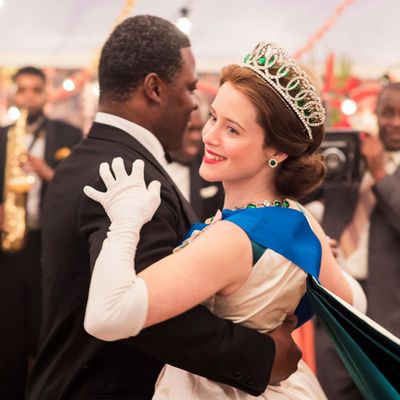
The second season of The Crown brings back all the sumptuous, high-production-value, ultra-British refinement that characterized its first season. But it also does something different: It loosens up a bit.
While season one functioned as a Queen Elizabeth II origin story about the young monarch’s adjustment to her new duties — and in particular, her relationship with Prime Minister Winston Churchill, played with blustery verve by John Lithgow — the ten episodes arriving Friday on Netflix broaden the canvas to explore the fragility of various relationships, both personal and political. Although it’s still very much a serious drama, the show, set this season between 1956 and 1963, has a warmer pulse. Reflecting the march toward more modern times, it’s also sexier, especially every time Princess Margaret (Vanessa Kirby) shows up onscreen to suck on a cigarette and smolder. There are many pleasures in this season of The Crown, but one of the greatest is watching Kirby blow smoke and find new ways to convey that she is soooo over everyone and everything in her vicinity. (Another pleasure: watching the heat that’s generated when she meets photographer Antony Armstrong-Jones, portrayed, due to the grace of the British TV gods, by the dashing Matthew Goode.)
Romance and marriage — particularly of the strained sort — are running themes, most notably when it comes to Elizabeth (Claire Foy) and her husband Philip (Matt Smith), whose troubled relationship takes center stage in the first three episodes. But tenuous alliances of other sorts are also on display within the extended royal family; between members of the international community and Great Britain, whose reputation takes a whacking in the wake of the Suez Canal crisis; and between the British people and the queen herself, who’s sharply criticized for being out of touch with her subjects. This season — largely written by series creator Peter Morgan, screenwriter of The Queen and Frost/Nixon — would be a transporting, thought-provoking experience under any circumstances. But it’s especially fascinating to watch right now. While Elizabeth’s attitudes are quite conservative, especially by today’s standards, there is also something deeply encouraging in seeing a leader who insists on projecting decency.
“The age of deference is over,” the monarch is told at one point by journalist John Grigg (John Heffernan), who publicly chastises the outmoded royal family and Elizabeth’s stilted way of addressing the public.
“What is left without deference?” she asks. “Anarchy?”
Pretty much, Queen E. Pretty much.
With Churchill no longer prime minister, Lithgow is, save for a flashback, out of the picture. His presence is missed, but the consistently excellent cast more than makes up for that absence. Foy, superb in season one, sinks even more comfortably into the skin of the fusty, old-fashioned, but sometimes surprisingly generous ruler of England. When Elizabeth occasionally — very occasionally — smiles or giggles, Foy plays the moments as if the queen has finally given herself a permission slip to experience joy. And when Elizabeth is angry, Foy knows just how to radiate a sense of calm while enabling the muscles in her neck to tell a completely different emotional story.
Smith can be deliberately maddening and arrogant as Philip, but he also dollops so much drollery into his line deliveries that you can’t help but be charmed by him, and understand why Elizabeth is, too. In a few scenes, Philip and Margaret even become partners in eye-rolling, one of the many ways in which Morgan and his co-writers and directors add levity to their reenactment of British history.
Of course, the sheer beauty of the costumes and production design in The Crown cannot be overstated. Gorgeous vistas from all over the globe splash across the screen when Philip goes on a five-month tour of various British territories, and the interiors of Buckingham Palace are just as rich with vibrant, opulent detail. At no point do you watch this show without thinking two thoughts: “Wow, that’s beautiful!” and “Jesus, that looks really expensive!”
But what is most striking and instructive about the second season of The Crown is Elizabeth’s capacity to take modest but meaningful steps toward change. On more than one occasion, the queen arrives at an opinion, then receives new information and revises that opinion accordingly. She’s not always right, but she listens, a quality she rather pointedly tells Prime Minister Harold Macmillan (Anton Lesser) — who really should be called Prime Minister Mansplain — is vital in a leader.
On every level, The Crown is deserving of praise. But it’s that subtle emphasis on the idea that even the most stubborn among us can at least try to evolve that makes it vital end-of-2017 viewing.


